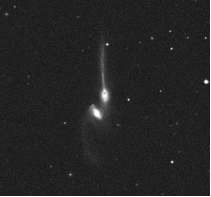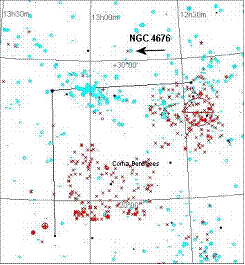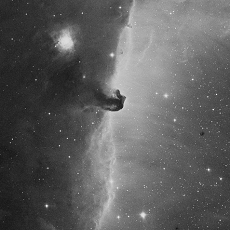Achieving the Unexpected
Jack Kramer
Deep sky observers always test the limits. And it's common to hear someone say, "I've never been able to see _____". (Fill in the blank.) But I always hope they keep on trying.
Urging continued effort isn't a hollow platitude, because things do change from night to night. Atmospheric conditions, in particular, vary to the point that it's sometimes hard to predict whether an otherwise clear night is really going to be conducive to seeing the object of your search. Then sometimes it's almost as if a curtain is raised and we're able to go beyond what had once seemed to be the limit of our capability.
It's also a good idea not to put undue credence in what some "experts" say because they can fall victim to preconceptions, even to the point of giving short shrift to all but the brightest deep sky objects. J. B. Sidgwick's book Observational Astronomy for Amateurs, a massive British bible of observational astronomy published in the 1960s, devoted only two pages to deep sky observing! (What would William Herschel have thought about that?) A different caveat applies to Robert Burnham's Celestial Handbook - a three-volume guide to deep sky observing that is a wonderful reference work and great all-around reading. But now and then he states that details in certain objects are most likely unattainable in typical instruments used by amateurs. The first edition was written in 1966, and since then the capability of the average amateur's telescope has increased to the point that Burnham's observing advice is often dated.
A typical case occurred in 1995 while a bunch of us were observing in New Mexico and someone trotted out an article in Astronomy magazine that talked about the interacting galaxy pair NGC 4676A and 4676B in Coma Berenices. Known as "The Mice", these galaxies get their name because of long thin tails of stars caused by tidal effects of the collision.
 The article stated that they would only be visible in the very largest telescopes. Of course, we took that as a challenge, and despite their faintness (mag. 14.1) all of us were able to see them. My notes record that in my 10-inch I clearly saw the two galaxies, though not their tails.
The article stated that they would only be visible in the very largest telescopes. Of course, we took that as a challenge, and despite their faintness (mag. 14.1) all of us were able to see them. My notes record that in my 10-inch I clearly saw the two galaxies, though not their tails.
 Probably the Holy Grail for deep sky observers is the Horsehead dark nebula (B 33) that is seen against the faint background nebula IC 434 in Orion. It's visible under very dark skies in scopes as small as 8-inches, especially using a Hydrogen Beta line filter, popularly dubbed as the "Horsehead Filter". Yet many observers have been thwarted in their efforts to see it even with larger instruments. I had seen it in my old 10-inch from New Mexico but never from the Midwest. That is, until several years ago when I spotted it from my back yard in the 10-inch using a 40mm Pentax XL eyepiece with an Orion Ultra Block filter.
Probably the Holy Grail for deep sky observers is the Horsehead dark nebula (B 33) that is seen against the faint background nebula IC 434 in Orion. It's visible under very dark skies in scopes as small as 8-inches, especially using a Hydrogen Beta line filter, popularly dubbed as the "Horsehead Filter". Yet many observers have been thwarted in their efforts to see it even with larger instruments. I had seen it in my old 10-inch from New Mexico but never from the Midwest. That is, until several years ago when I spotted it from my back yard in the 10-inch using a 40mm Pentax XL eyepiece with an Orion Ultra Block filter.
 Now and then I'd take a look in the area, not really expecting to see the Horsehead, so it came as a surprise when it popped into view as a tiny formless notch in the background nebulosity. I haven't seen it from my back yard since then, even with the 12-inch. But I'll keep on looking. It shows conditions were just right on that one night. A good tip-off was that the E and F components of the Trapezium were especially obvious, as was NGC 2024, the nebula involved with Zeta Orionis (the lower left of the three stars in Orion's belt). And while a hydrogen beta filter would no doubt make it easier, this experience suggests that a narrowband filter such as a UHC or Ultra Block passes enough of the hydrogen beta emission line to be useful on the Horsehead.
Now and then I'd take a look in the area, not really expecting to see the Horsehead, so it came as a surprise when it popped into view as a tiny formless notch in the background nebulosity. I haven't seen it from my back yard since then, even with the 12-inch. But I'll keep on looking. It shows conditions were just right on that one night. A good tip-off was that the E and F components of the Trapezium were especially obvious, as was NGC 2024, the nebula involved with Zeta Orionis (the lower left of the three stars in Orion's belt). And while a hydrogen beta filter would no doubt make it easier, this experience suggests that a narrowband filter such as a UHC or Ultra Block passes enough of the hydrogen beta emission line to be useful on the Horsehead.
Finally, there's the issue of limiting magnitude a set of values that stipulate how faint an object you can see with telescopes of various sizes. These magnitude figures are to some extent theoretical, and I've learned not to take them as gospel. For more on these limits, there's an article in the archive on the LCAS public web site: Limits are meant to be broken
The objects cited here are just two of the many that have tested the limit of my scope's light grasp. You probably know of other deep sky objects that only reluctantly betray their whereabouts. It's just a matter of looking for them again and again, and maybe when you least expect to see them, there they are!
The deep sky images here are from the Palomar Observatory Sky Survey. The finder chart is from the freeware program Cartes du Ciel.
... published in the January 2008 issue of the NightTimes





